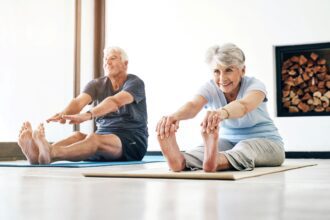Walking for health
Walking is a relatively simple exercise that almost everyone can do. We look into the benefits, how best to get started and where you can find your walking adventures. Read more here.
Spring now upon us its a great time to get outdoors more enjoy the better weather while also helping your health.
Benefits of walking
There are many benefits that come with regular walking. Here are some of the many benefits that regular, brisk walking has shown for older adults:
Improved health – Studies have repeatedly shown that regular walking can help manage weight, improve circulation, lower blood pressure and cholesterol and help keep signs of cardiovascular disease at bay. Regular walking will also improve your energy levels and increase your stamina.
Fights disease – Walking for an average of 30 minutes a day can lower the risk of heart disease, stroke, and diabetes by 30 to 40 per cent¹.
Strengthens bones, muscles, and joints – Walking helps maintain your bone density which reduces your risk of osteoporosis and bone fractures. Walking also lubricates your joints and helps strengthen your supportive muscles and can even significantly reduce (or even prevent) arthritis pain.
Improves sleep – Moderate exercise, such as walking can helps adults with sleep issues to fall asleep faster and sleep longer.
Balance and coordination – Walking has shown to improve balance and coordination, therefore reducing your risk of falls and other injuries.
Mood boosting – Walking, like most exercise, helps to naturally release your bodies endorphins and encourage circular breathing. Both lead to increased mood and other all-round positive emotional benefits such as increased confidence and can reduce anxiety or depression.
Social connectivity – Walking increases your chances of connecting with others. This can through chatting to neighbours while walking the dog or joining a walking club. There are many benefits of social contact for both mental and physical well-being.
Versatility – Walking is very versatile and can be done almost anywhere. You can enjoy walking while listening to music, looking at nature or having a chat with a friend. You can walk slow and steady, or increase intensity with short fast bursts or by going up and down stairs and hills. Walking is cheap, easily accessible and won’t leave a carbon footprint!
Exercise doesn’t need to be strenuous to be beneficial for your health. In fact, the Australian Physical Activity and Sedentary Behaviour Guidelines recommend older people aged over 65 do 30 minutes of moderate intensity activity each day².
Getting started
There are many things that you can do to prepare yourself for walking, some are completely necessary, like appropriate footwear, and other things are not, like tracking your walking distances. It’s up to you how much preparation you wish to do:
Visit a GP – It’s always a good idea to speak to your GP about the level and type of exercise that is suitable for you, especially if you haven’t exercised for a while, plan to try more strenuous walking or have a health condition or problem.
Appropriate footwear – You will need to make sure that you wear correct fitting and comfortable shoes (and socks) for walking. A podiatrist can assist with the type of footwear you need if you have foot problems. You can still walk with a cane or walker, so don’t let this hold you back.
Appropriate clothing – Dressing appropriately for the weather is important, layers are best for removing and replacing when you heat up and then cool down again. Always check the weather, wear sunscreen, stay hydrated and consider skipping outdoor walks on extreme temperature days.
Warming up – some simple stretching is a good way to warm up and stretch your body before you start walking. Stretching can also improve flexibility and help prevent injuries. It is also a great idea to do cool down stretching after each walk.
Start off small – If you rarely do physical activity start by walking for 10 to 15 minutes, three to four times a week at a comfortable pace. After a few weeks, you should find that you can walk a little further and faster, and may want to gradually increase the frequency to five, six or seven times a week.
Technique – Walk at a steady pace, swing your arms loosely and freely by your side and stand as straight as you can. Your feet should step in a rolling action from the heel to the toe.
At your own pace – Always walk at your own pace and listen to your body. If you need to stop or take a break, do it. Don’t push yourself too hard, know your limitations.
Monitor your walking – You can track your walking via an exercise app, pedometer or fitness gadget. These apps and gadgets often provide information on how many steps you have done, the distance walked, calories burned and more. They can help motivate you too! Visit this website to see the best ways to measure how far you have walked.
Walking companions
You may choose to walk alone, but if you do not want to walk alone, think about these ideas for your walking companions:
Friends – Walking with a friend or family member can make walking more fun and enjoyable and you can motivate each other. It is also more likely that you will walk longer and more often if you do it with a family member or friend, and its usually safer than walking alone.
Walking groups – Joining a walking group is another way to stay active, meet new people and keep motivated. The heart foundation walking website has a list of walking groups here – walking.heartfoundation.org.au/ you can even create your own walking group on this page. Walking groups are all across the country, some walk in local areas, some plan larger and grander walks, while others meet weekly to walk in shopping malls!
Pets – Walking with a pet can give you company but also a bit of peace and quiet. Consider walking a neighbours or friends pet if you don’t have your own but still want the company. Its guaranteed they will love it and you will make a new friend or two in the process.
Where to walk
You can walk anywhere relatively easily. In your own neighbourhood, your local beach, park or reserve. It can be interesting to try somewhere a bit different or special or even more off the grid. Here are some walking ideas that may inspire you beyond your local community:
National Parks – Each state and territory has many national parks and walking paths or hikes. Check them out by looking up your state or territory’s national park website.
Coastal walks – coastal walks are well established in most of Australia. Some may be more challenging with steps and changes in elevation, like this one walkingmaps.com.au/walk/3322 Hallett Cove conservation walk that includes a board walk. However there are many other flatter options that can allow you to take in the coastal views.
Iconic walks – Many areas in Australia have walks that incorporate the local attractions, such as the Sydney Harbour Bridge explorer walk. Whether it’s the icons in your own region or elsewhere, these walks should also include talking your camera.
www.walkingmaps.com.au is a great website you can use to look up walks by location that allows you to choose criteria such as wheelchair access, drinking water availability and more.
Keep it going
Look for creative ways to keep you motivated and keep you walking. Here are some ways you could change things up:
- Change the scenery of your walks by trying different parks, the beach, a different route in your neighbourhood
- Go on an ‘art walk’ or ‘history walk’ in your local community
- Take your grandkids, invite a new friend or neighbour to join you
- Challenge yourself to a different walk in a different neighbourhood each week
- Join a new walking group, or start your own walking group
- Incorporate bird watching or garden viewing into your walks
- Visit a different national park
Make it into a holiday?
If you are an experienced walker or hiker and have built up your physical abilities to a higher level, you may be interested in a multi-day hike. You can self-organise these or go on a guided walk. There are many guided walking holiday companies that organise walking trips throughout Australia. Sign up to a guided walks newsletters such as www.australianwalkingholidays.com.au/ or greatwalksofaustralia.com.au/ and check out their guided walks all across Australia.
If a guided trip isn’t your thing, you can visit websites such as www.trailhiking.com.au/, www.victoriawalks.org.au/ or www.walkingsa.org.au/. These websites aren’t selling holidays, but they provide you with a lot of ideas and information on walking that can assist in planning your own multi-day walks.
References:
¹ walking.heartfoundation.org.au/
² www.betterhealth.vic.gov.au/health/HealthyLiving/Walking-the-benefits-for-older-people
companionsforseniors.com/2019/04/health-benefits-walking-seniors/
walking.heartfoundation.org.au/
www.healthdirect.gov.au/physical-activity-guidelines-for-older-adults











